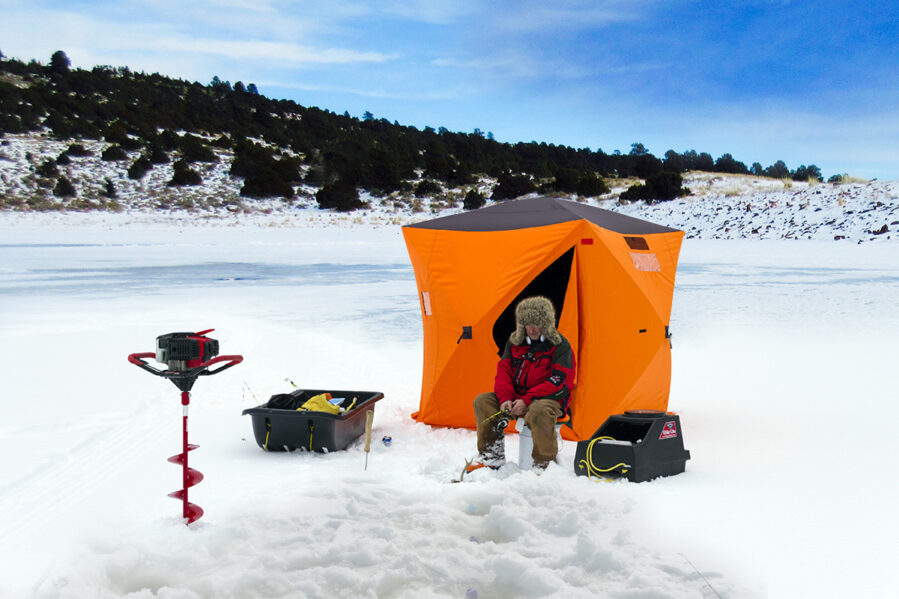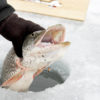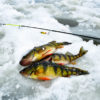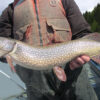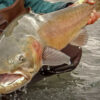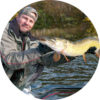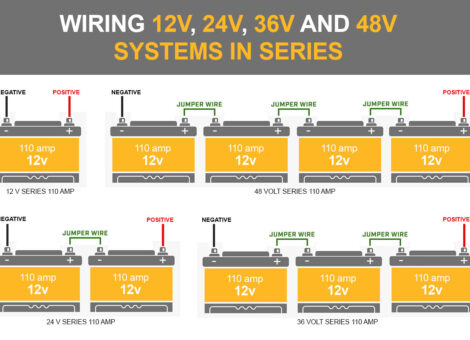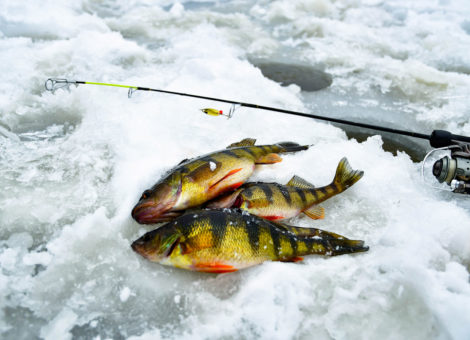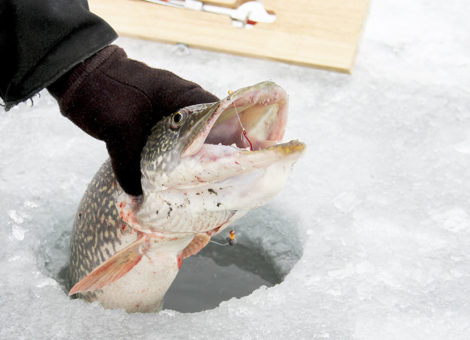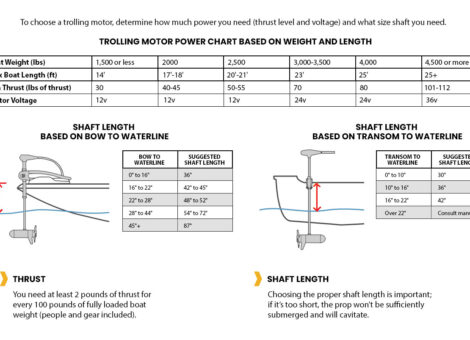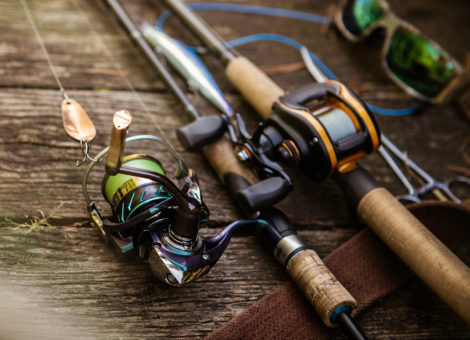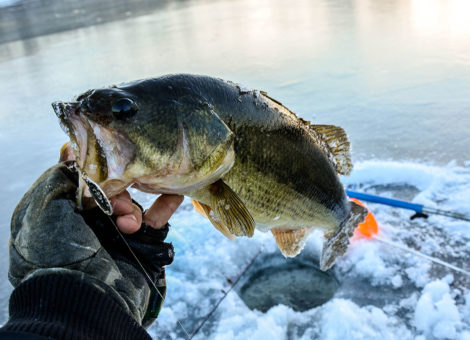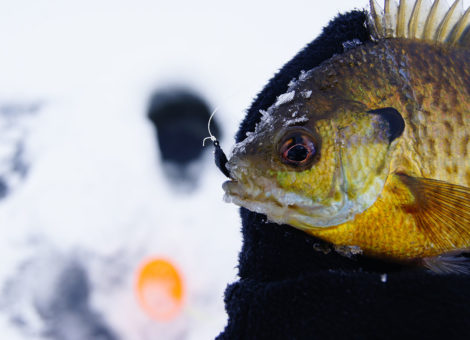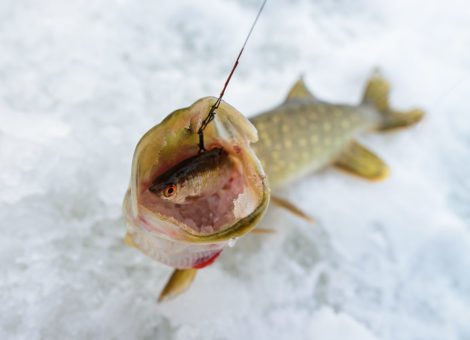The gear required for ice fishing is different than that used for fishing open freshwater. Having the correct ice fishing gear ensures a safe, productive and enjoyable experience while hard water fishing under the ice during the coldest months of the year.
There are two types of ice fishing gear: essential and non-essential. Essential gear includes ice rods, reels, augers, fishing line, ice scoop, sleds, bait, lures and terminal tackle. Non-essential, or optional gear, includes tips ups, shelters, heaters, ice clothes, and electronics.
Essential Ice Fishing Gear
Essential ice fish gear is required for fishing all fish species under the ice including panfish, trout, bass and pike. The following table provides a list of all essential ice fishing gear along with equipment selection tips and recommendations.
| Equipment | Description/Tips |
|---|---|
Ice Fishing Rod(s) | Range from 16‘’ to 48‘’ in length. An all around good ice rod is a 28 inch fast-action, medium rod. Graphite ice rods are recommended when ultimate sensitivity is required. Fiberglass rods are more durable and economical. |
Ice Fishing Reel(s) | Spinning and Inline are the most common ice fishing reels. Spinning reels are ideal for targeting larger fish in deeper water (greater than 25'). Inline reels are best for targeting panish in shallower waters (less then 25'). |
Ice Auger | There are 5 types of ice augers: Hand, Electric, Gas-powered, Propain-powered and Cordless Drill. Hand augers are light weight and reliable, but physically demanding. Power drills are ideal when multiple holds are required. |
Fishing Line | There are 3 options for ice fishing line: braid, monofilament and fluorocarbon. Monofilament is the most common line used for ice fishing. A setup using braid for the main line and fluorcarbon as the leader is a popular option. |
Ice Scoop | An ice scoop, or ice skimmer, will enable you to keep your fishing hole clear of ice and remove any slush left behind from drilling the hole. Modern ice skimmers with a plate are a popular alternative to traditional ladle stype ice scoops. |
Sled | A quality ice fishing sled will enable you to transport your fishing gear across the ice. Consider size, weight, durability, price and accessories when selecting a sled. The most popular ice sled is the good ol'fashioned tobogaggan. |
Bait | The most common baits used for ice fishing include wax worms, maggots, mealworms, spikes, wigglers (mayfly larvae) and minnows. Some jurisdictions do not allow live bait. Check local fishing regulations before your trip. |
Lures | Artificial lures are effective for catching fish under the ice. The most common and universal ice fishing lures include spoons (rattle, flutter, slab), lipless crankbaits (large and micro), glide baits and tungsten jigs tipped with cut bait. |
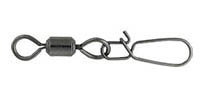 Terminal Tackle | The basic terminal tackle required for ice fishing is needle-nose pliers, sinkers, swivels and snaps, a filet knife for cleaning fish, scissors, line clippers, hooks and bobbers. |
Optional Ice Fishing Gear
Non-essential, or optional, ice fishing gear isn’t required, but nice to have if you plan on doing much fishing under the ice. The following table provides a list of non-essential ice fishing gear that will enhance your catch rate, safety and fishing experience.
| Equipment | Description |
|---|---|
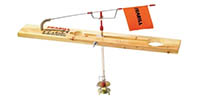 Tip Ups | Tips ups allows anglers to fish multiple baited lines at once under the ice. There are four popular types of tip ups. These include Windlass, Pro-Thermal, Hardwood and Wood Stick tip ups. If you're just getting started, make sure to buy a quality tip up. |
Ice Shelter | Ice shelters provides protection from the elements and provide a for an enjoyable experience fishing under the ice. The two most popular types ice shelters are Hub shelters and Flip-Over shelters. |
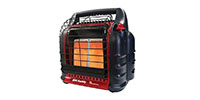 Portable Heater | A portable heater is a non-essential ice fishing item that is highly recommended for temperatures below 20 degrees Fahrenheit. Ice fishing heaters are propane or electric powered and can produce from 3,000 to 12,000 BTU. |
Fish finder | Display historic and real time sonar (RTS) to help locate fish under the ice. Entry-level fish finders with traditional 2D sonar range from $300 to $500. Higher-end finders with GPS and forward-facing (360) technology can run up to $2,500+. |
Flasher | Provide real time sonar (RTS) that shows the bottom, any fish and lure movement directly below the fishing hole. Flashers are a great alternative to using a traditional ice fishing finder and are often preferred by anglers. |
Ice Fishing Rod(s)
If you’re new to ice fishing, your best bet is a standard 28-inch, fast-action medium jigging rod which will provide sensitivity and strength. This rod will work for larger panfish and perch, as well as walleye, whitefish and trout. It will even reel in some smaller pike and lake trout. But as is the case with most fishing applications, there isn’t a one-size-fits-all rod for ice fishing.
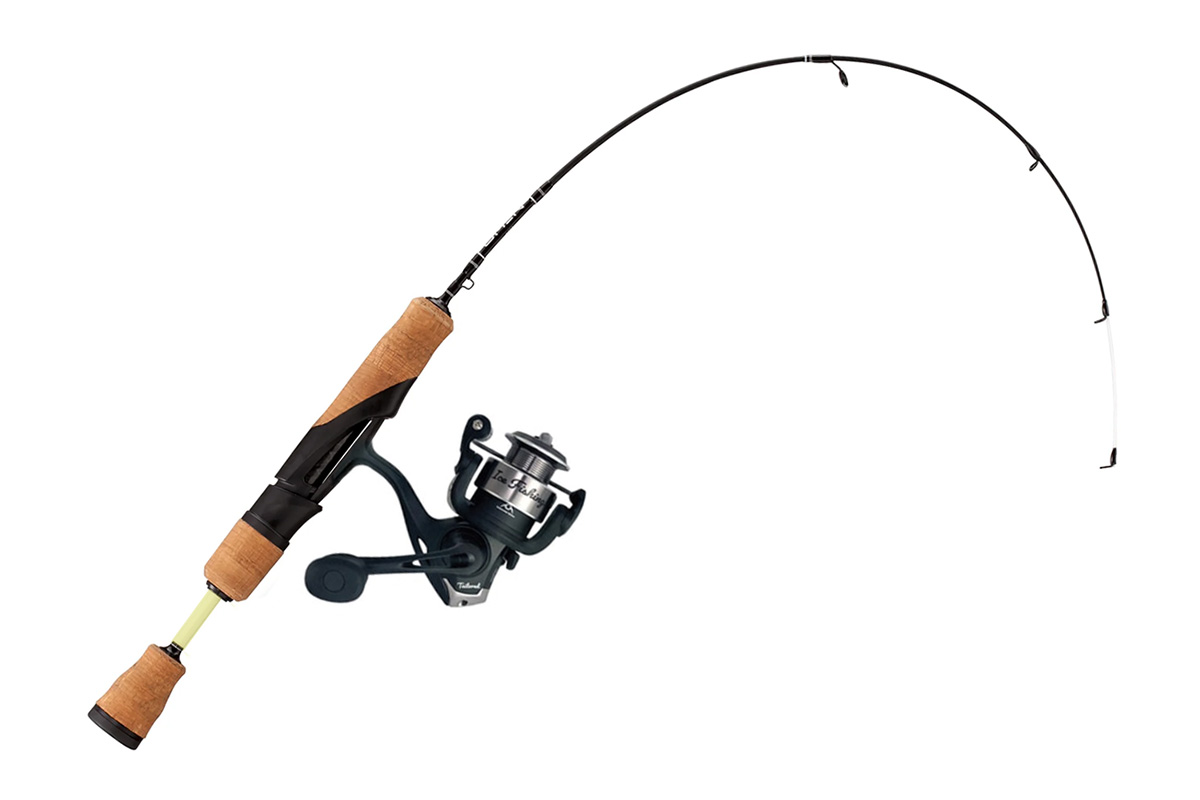
If you want to get a little more precise and improve your fishing experience, you’ll want to use a rod made for your target fish species. When selecting an ice rod the main metric you want to look at is power. In the same manner you’d select a rod for fishing open water, when selecting an ice rod, you want to match the power of the rod to the target fish species.
Rod Power
Rod power is the amount of force required to bend the rod along its blank. Common power classifications for ice rods are ultra-light (UL), light (L), medium light (ML), medium (M), medium heavy (MH), and heavy (H). Rod power closely coorelates to the size of line you are fishing. Not suprisingly, the larger your fishing line, the greater the power requirement for your rod.
As a rule of thumb, the smaller the fish the lighter the power and line requirement. Ultra-light rods are good for panfish, light rods for perch, light to medium rods for walleye, and heavier rods for your larger predatory fish like pike and lake trout. With ice rods you don’t want to over do the power. You want your rod to be sensitive to bites. I’d even recommend always going on the slightly lighter side.
Rod Action
Closely related to rod power is rod action. Beginning ice anglers will often confuse the two terms, but they’re different. Again, power is how much force is required to bend the rod, where “action” refers to where along the rod the bend occurs. The most common classifications for action are ultra fast (UF), fast (F), moderate fast (MF), moderate (M), and slow (S).
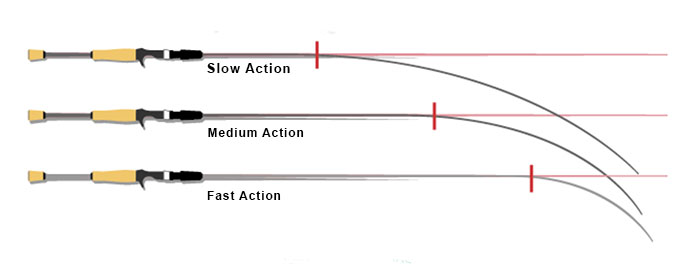
Fast action rods bend towards the tip, medium action rods bend toward the middle, and slow action rods bend closer to the handle. Most ice anglers prefer a fast- or medium-action rod that will allow them to feel the slightest bite, yet get a solid hookset.
The following chart provides recommended ice rod power and action by target fish species.
| Fish species | Rod Power | Rod Action |
|---|---|---|
| Panfish (sunfish, perch, crappie, bluegill) | Ultra-light | Slow action |
| Trout (Rainbow, Brown) | Light to medium | Moderate |
| Walleye | Light to medium | Moderate |
| Saugeye | Light to medium | Moderate-fast |
| Smallmouth bass | Medium | Moderate |
| Largemouth bass | Medium to heavy | Moderate |
| Northern Pike | Heavy | Moderate-fast |
| Muskellunge | Heavy | Moderate-fast |
| Lake Trout | Heavy | Moderate |
Ice Rod Type: Graphite vs Fiberglass
Selecting your rod material is another important consideration. Your two main choices are graphite and fiberglass—along with a variety of composites. Graphite rods are lighter and more sensitive than fiberglass rods, and they’re also more expensive. But if ultra sensitivity is high on your list, then a solid graphite blank is your best option.
A ssolid or tubular graphite blank is going to be sensitive but still provide the backbone you’ll need to get a solid hookset and easily reel in the fighters. A fast-action graphite rod is a popular choices for seasoned ice anglers who want the ability to dance a jig in just the right way to entice shy biters.
Fiberglass is still a popular choice and probably the more used rod among ice anglers. It’s more economical and gets the job done. Fiberglass rods are mostly medium action, tending to bend along the blank, and have a smoother hookset. Two of the big benefits of using fiberglass are price and durability. Fiberglass is cheap and withstands freezing temperatures better than graphite.
So which is better? It really just depends. Graphite rods are geared for performance and sensitivity. If you want to feel the fish strike, graphite is the way to go. But with a good spring bobber or strike indictor affixed to your line, a fiberglass ice rod works just as well.
Rod Length
I’m going to say 28 inches is a good rod length for most ice fishing applications, but sometimes a slightly shorter rod, or a longer rod may make sense—the decision will really depend on fishing conditions and what you plan on catching. Ice fishing rods range from about 16″ to 48″ in length.
Longer rods yield solid hooksets, provide additional leverage when fighting larger fish, and are a bit more forgiving. However, in tight quarters they can become really inconvenient, really fast.
Short rods are less forgiving and provide less shock absorption when you’re reeling in a fighter. In turn, your arms and reel drag must compensate. One of the big benefits of fishing with a shorter ice rod is convenience. They’re easy to port around and much easier to fish with in tight quarters—such as an ice shelter. Children also tend to prefer shorter rods when ice fishing.
If you decide to go short, using a graphite rod over a fiberglass rod will provide additional strength and backgone.
Additional Rod Considerations
Another consideration when choosing an ice fishing rod is application. Are you going to be fishing baits or lures? What fishing technique will you be using? Spooning for lake trout, finesse-jigging crappie, or swim-baiting walleye all require different ice rods.
And if you plan on targeting multiple species, bringing along several rods with various actions, rigged and ready to go, is a good idea. Just as a pro-golfer would never succeed with just one golf club, an angler should have a few different ice rods in his arsenal.
Ice Fishing Reel(s)
Some will argue that the rod is the most important item in an angler’s ice fishing arsenal. I tend to differ. A good ice rod will greatly improve your catch rate and fishing experience, but you could catch a fish under the water using a stick, some fishing line and a hook—if you had too. But without a reel your just a stick in the mud.
There are several types of reels that can be used for ice fishing, but all good ice reels have one thing in common—durability. Ice fishing takes place in some of the harshest environments. Whichever reel you use must be designed and manufactured to withstand the elements.
In addition to durability, there are several other features that make a good ice fishing reel. That’s why I recommend purchasing a reel that is specifically designed for ice fishing. The most common types of ice fishing reels are spinning reels, that have a flip up bail, and inline reels.
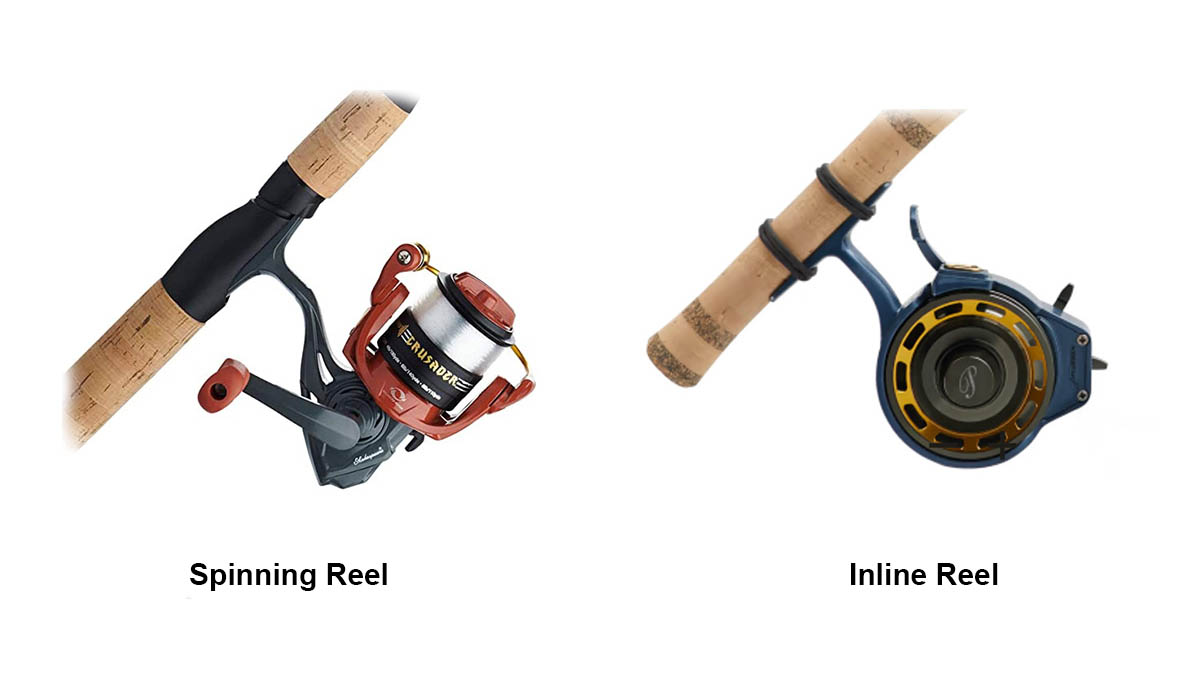
The main difference between spinning and inline reels is the orientation of the spool on the rod, and the direction the line comes out. A spinning reel is vertically aligned with the rod. An inline reel sits laterally on the rod. Each rod had its pros and cons.
Spinning Reel Pros & Cons
| Pros | Cons |
|---|---|
|
|
The most common size spinning reel for ice fishing is an ultra light model between 1000 and 2500. For ice fishing with a spinning reel, a smaller reel is required to compensate for the smaller size of the ice fishing rod, which on average ranges between 16 and 24 inches.
Inline Reel Pros & Cons
| Pros | Cons |
|---|---|
|
|
Inline reels for ice fishing are similar in appearance and functionality to a typical fly reel. The spool of the inline reel hangs directly below—and parallel to—the ice rod. This position allows fishing line to run off the spool in line with the rod and greatly minimizes twisting.
Spinning and inline reels are by far the most popular options for ice fishing, but there are few other reel types that will also work. These include baitcasting reels, palm reels and the schooley rod reel combo. Baitcasting reels are common for spring and summer fishing, but not as popular for ice fishing. Palm reels are popular in Europe and now growing in popularity in the states. The Schooley is as “old school” as they come and are great for ice fishing.
The following table provides an overview of each type ice fishing spinning reel with a functional description.
| Reel Type | Description |
|---|---|
| Spinning | Most popular ice fishing reel. Is easy to use and economical. Ideal for targeting larger fish at depths beyond 25 feet. Versatile and provides a relatively fast retrieve. |
| Inline | Ideal for targeting smaller panfish, such as bluegill, perch and crappy. Durable in cold, harsh environments. Ideal for shallow water ice fishing to depths of 25 feet. |
| Baitcaster | Not as popular as either spinning or inline reels. However, the baitcaster has less line twists and can handle larger fish. If you know how to use a baitcaster, use it. |
| Palm | Has a compact design that allows for easy carry and a high level of control. They are highly sensitive and can detect the smallest bite. Ideal for panfish and precision jigging. |
| Schooley | Small compact design that uses a spring bobber pole and jig reel. Are very sensitive to any bite. Allow for exact depth control via a depth marking pin. Great for fishing panfish. |
As I mentioned previously, the most common size for a spinning reel for ice fishing is between 1000 and 2500. Spinning reels range in size from 500 Series on low end to larger 8000 Series, but you’ll never need to go above 4000 Series even if you’re targeting larger catches. If you opt for the 2500 Series you’ll be well prepared to catch just about any fish under the ice.
Some manufacturers use a different convention than standard 1000+ sizing. They’ll only use the first two numbers. So a 2500 Series would called ’15’, a 2000 Series ’20’, 1500 Series ’15’ and so on. The most popular spinning reel sizes for ice fishing, their line capacity and target fish species are found in the following table.
| Reel Size | Line Mono/Braid | Capacity Mono/Braid | Fish Species |
|---|---|---|---|
| 1000 | 2lb/4lb | 125yds/150yds | Perch, Bluegill, Crappie, Panfish |
| 2000 | 4lb/6lb | 100yds/125yds | Perch, Bluegill, Crappie, Panfish, Trout, Whitefish |
| 2500 | 4lb/6lb | 110yds/140yds | Northern Pike, Muskie, Walleye, Bass, Whitefish, Saugeye |
| 3000 | 6lb/8lb | 145yds/190yds | Northern Pike, Muskie, Walleye, Bass, Lake Trout, Catfish, Saugeye |
| 3500 | 8lb/10lb | 135yds/220yds | Northern Pike, Muskie, Lake Trout, Walleye, Catfish |
| 4000 | 10lb/14lb | 230yds/280yds | Northern Pike, Muskie, Lake Trout, Catfish |
Now that you’re familiar with the different reels for ice fishing, just remember, you can catch a fish with just about any reel as long as you know how to use it.
Ice Augers
Drilling holes is one of the most important aspects of ice fishing. Before you can fish under the ice you have to get through it. And you may need to do so several times before you find where the fish are hiding. Having a reliable, heavy duty auger is one of the best investments you’ll make if you’re going to get serious about ice fishing.
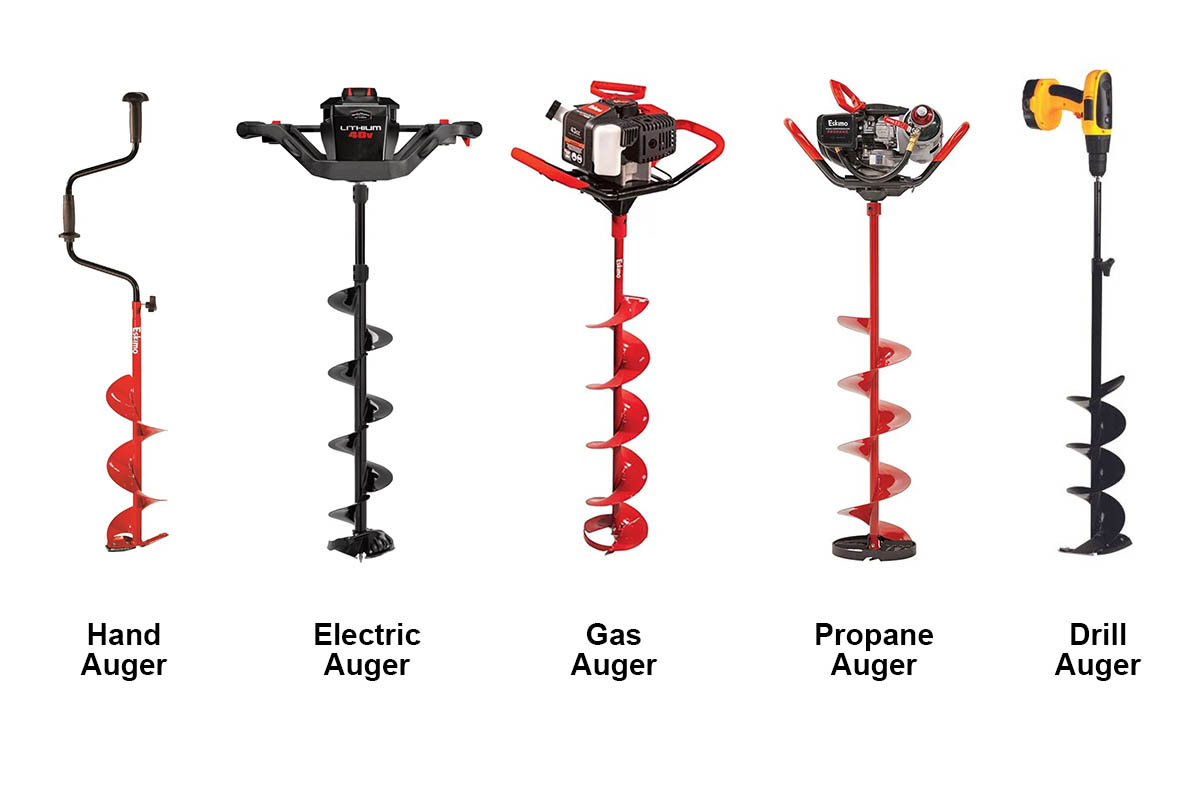
Before running out and buying the first ice auger you see, there are several things to consider. When evaluating the type of ice auger that is best for you, consider the following:
- Fishing style and strategy – Your fishing style will determine how many holes you’ll be drilling. Are you going to fish from just a few holes? If so, a hand auger will do the job. If your strategy involves drilling hundreds of holes, you’ll probably want a power auger.
- Cost – Auger prices run the gamut and vary by auger type. A manual hand auger will run you about $80, and you can pick it up at just about any sporting goods store. Add a motor to the auger and now you’re looking at a price tag of $400 to $1000.
- Power – If you decide you need a power auger, how much power will you need? The more holes you plan on drilling, and the larger the cutting diameter, the more power you’re going to want. You also need to consider ice thickness. If your ice is much thicker than 7 inches, you’ll probably want an auger with as much power as you can afford.
- Cutting diameter – Cutting diameter determines hole size. The larger the hole, the greater the cutting diameter required. Generally, the smallest cutting diameter is about 4 inches—just big enough for a perch or bluefish to slip through. For larger fish, you’ll need a larger hole, and hence, a larger cutting diameter. Make sure your auger has enough power for the cutting diameter you desire.
- Weight – Before you buy an auger, see how much it weighs. If you’re going to be sitting inside an ice shelter all day in the same spot, a heavy auger may be doable. But if you’re going to be drilling holes all over the lake, porting around a lighter weight auger makes a lot more sense.
- Durability – Not all augers are made the same. The materials used to construct an auger will determine how well it holds up against the elements and under pressure. Augers with steel flighting are durable, but they weigh more and tend to accumulate ice buildup. Composite flighting is lighter, and resists ice buildup, but is not as durable as steel. You have to find the right balance.
- Blades – Augers come with two types of blades: shaver or chipper. Basic shaver blades are flat, smooth and fast cutting. Higher end shaver blades are curved and improve drilling efficiency. Chipper blades are more durable than shaver blades—ideal for cutting dirty ice—but are slower cutting.
- Comfort and Portability – If you’re going to be moving around on the ice all day, you really need to consider the comfort of using and transporting your auger across the ice. Does the auger balance in your hands when carrying it? How does the auger feel when in use? Read reviews and talk with other anglers before making a purchase.
Once you have an idea of general requirements, it’s time to determine auger type. There are 5 types of ice augers to choose from—each with advantages and disadvantages. The following table lists each type of ice auger along with the most important considerations for helping you determine if the auger is right for you.
| Auger Type | Description |
|---|---|
| Hand | Hand augers are affordable, easy to use, quiet, durable and light weight. They can be physically demanding and unproductive when ice is thick or multiple fishing holes are required. |
| Electric | Electric augers are fast drilling, easy to operate, quite, light weight and start right up. They often have LED lights for night time fishing. Length of use is limited to battery charge. |
| Gas-powered | Gas augers are powerful and reliable. They don't rely on a battery, so they have unlimited usage. If you're drilling multiple holes through thick ice, gas is great. They are noisy, heavy and require routine maintenance. |
| Propain-powered | Propain augers are a great alternative to gas augers. They are quiter, require less maintenance, but still provide plenty of power. They typically run on a one-pound propane cylinder. They make experience performance issues in extreme cold. |
| Cordless drill | You can now drill your holes using a professional-grade 18- or 20-vole, lithium, brushless 1/2-inch chuck drill attached to an ice auger. This assembly has grown in popularity among ice angers over the years. Cordless drill augers are lightweight, portable and powerfull. |
There are several high quality auger brands on the market. Some of the more reputable include Strikemaster, ION, K-Drill, Jiffy, Eskimo and RAZR.
Fishing line
Obviously you can’t fish without fishing line, but which type of line is best for ice fishing? You have three options: braid, monofilament, and fluorocarbon. While each of these lines is different, they all have one thing in common. They’re manufactured to perform in sub-zero temperatures.
The follow chart lists all three line options identifying the pros and cons of each for ice fishing. If I had to choose just one line to work with, it would be monofilament—but I’ll let you decide for yourself. Opinions vary.
| Line Type | Description |
|---|---|
| Braid | Braided line is non-stretch, sensitive, abrasion resistant, and has low memory. It provides a good hookset. However, braid can retain water which may accumulate on the reel. Best fished at temperatures above 20 degree fahrenheit. Braid is visible and not ideal for fishing clear water. Use only a tight weave. |
| Monofilament | Monofilament is strong, versatile and has low visibility in water. It performs well in cold, harsh environements and sheds water well. You can use mono all day without your reel freezing up. I recommend low-stretch monofilament to improve sensitivity to bites. This is especially important when fishing deep water. |
| Fluorocarbon | Fluoro line is about as stealthy as they come. It's almost invisible to fish under water. It's strong, sensitive to bites, sinks well (it's heavy) and doesn't stretch like monofilament—all important attributes of an ice fishing line. |
Most anglers with a little experience will not limit themselves to just one line—they’ll use a combination. A setup that works for me is to use fluorocarbon as my leader line and either monofilament or braid as my main line. Using braid as the main line ensures my setup is sensitive to bites, while the fluorocarbon leader maintains my line nearly invisible to fish. Braid also lasts a lot longer than either flourocarbon or mono so I’m not having to change out my main line each year.
A good leader length can be anywhere between 5 and 15 feet depending on your target fish and depth. Attach your leader to your main line using a line-to-line knot and you’re good to go. Connecting braid to fluorocarbon using a swivel is another option. Use a swivel to reduce line twist and spin whenever your fishing a lure.
When using small spools, you’re likely to experience line “memory.” This is when your line coils after being stored on a reel. Sort of like removing hair from a curling iron. You can minimize line memory by using high quality fishing line, avoid leaving your line exposed to the sun, stretching your line before use, and using a larger spool. Braid tends to have the least line memory.
Line Size
You’ll typically use a relatively smaller weight line for ice fishing than you would when fishing open water. Where a 6- to 8-pound text would qualify as “light” for open water, for ice fishing a light line is going to be in the 4-, 3- and 2-pound range.
| Fish Species | Reel Size | Monofilament | Braid |
|---|---|---|---|
| Panfish | 1000 | 2lb | 4lb |
| 2000 | 4lb | 6lb | |
| Trout | 2000 | 4lb | 6lb |
| Whitefish | 2000 | 4lb | 6lb |
| 2500 | 4lb | 6lb | |
| Bass | 2500 | 4lb | 6lb |
| 3000 | 6lb | 8lb | |
| Walleye | 2500 | 4lb | 6lb |
| 3000 | 6lb | 8lb | |
| 3500 | 8lb | 10lb | |
| Northern Pike | 2500 | 4lb | 6lb |
| 3000 | 6lb | 8lb | |
| 3500 | 8lb | 10lb | |
| 4000 | 10lb | 14lb | |
| Lake Trout | 3000 | 6lb | 8lb |
| 3500 | 8lb | 10lb | |
| 4000 | 10lb | 14lb | |
| Catfish | 3000 | 6lb | 8lb |
| 3500 | 8lb | 10lb | |
| 4000 | 10lb | 14lb |
Ice Scoop
An ice scoop, or ice skimmer, isn’t the most exciting piece of gear in your ice fishing arsenal, but it’s very useful. An ice scoop allows you to keep your fishing hole from freezing over and your line from cutting.
The concept of an ice scoop is pretty straight forward. As the water in the fishing hole begins to freeze over you use the ice scoop to clear away the ice, and keep the hole open and ice free. It’s also useful for clearing away the slush left behind from making the hole.
A traditional ice scoop has a simple design. Its just a large metal ladle type spoon with holes in it. An ice scoop works at temperatures above -20 °F. When temperatures fall below this point, a heater may be required to keep an angler’s fishing hole from freezing over.
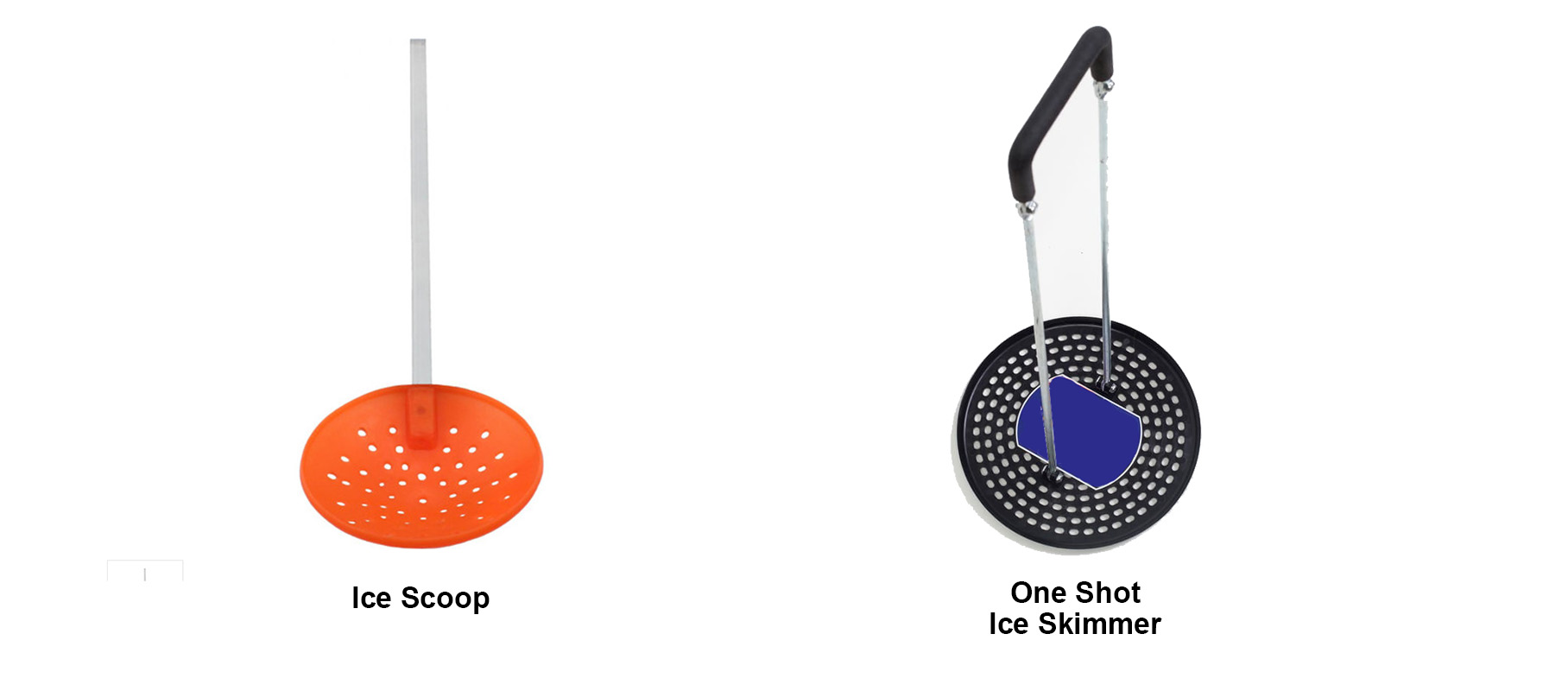
There is now a more modern ice skimmer that has a circular plate with holes instead of a scoop. The holes allow water to past through the plate while ice and slush are captured and removed. The plate comes in various diameters to accomodate different hole sizes. The plate is passed through the fishing hole using a 20″ to 30″ inch handle. These skimmers are easy to use and much faster for clearing a fishing hole.
Sled
Unless you plan on hauling all your gear around on the ice from the back of your vehicle, or lugging it around in a bucket, your best option is to use an ice fishing sled. Ice fishing sleds are affordable, durable, and will greatly enhance your experience on the ice.
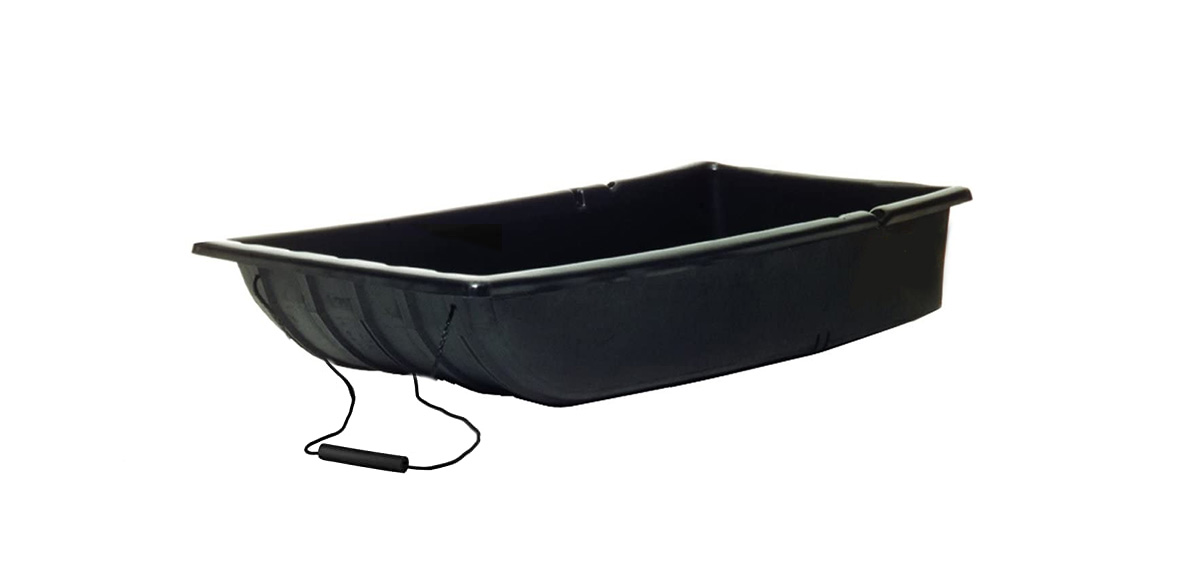
Whether you plan on pulling your sled behind an ATV or by hand, you want to make sure your sled meets a few basic criteria. Factors to consider before purchasing an ice fishing sled include capacity/size, weight, durability, towing method, color, accessories, price, and location. Use the following table to evaluation your sled purchase.
| Factor | Considerations |
|---|---|
| Capacity/size | How much gear will a sled hold? Will your gear stay inside the sled as it's towed on the ice? Itemize all of the gear you and your group will be bringing and make sure your sled is big enough to handle it. I highly recommend purchasing a cover with our sled. |
| Weight | Unless you're the young version of Arnold Schwarzenegger, you want to minimize the weight of your sled. When looking for a sled, find one that is well built, yet light weight. Look for a sled with molded runners. It will be easier to pull more weight through the snow or over the ice with molded runners. |
| Durability | The most durable style is the toboggan sled. For plastic select polyethylene construction. Where the rope is attached to the front should be reinforced in some way. The sled should have a contoured hull in the front for easy gliding through the snow with a reinforced bottom to handle bumps and rocks. |
| Towing Method | If you're going to purchase a sled to tow behind an ATV or snowmobile, it needs to be extremely durable to handle the extra punishment of being pulled fast and hard. You can also purchase a slightly larger sled if you're not going to be pulling it by hand. But remember, towing your sled behind an ATV isn't always an option. |
| Color | A lot of anglers prefer a black or earth tone colored sled. Any color will work but I recommend getting an orange or brightly colored sled. A bright color is easy for you or someone else to spot from a distance. In the event you get lost, or can't immediately locate your position, a brightly colored sled will help identify your location. |
| Accessories | You don't want to get crazy, but it's nice to have a few accessories that make lugging your gear around a little more fruitful. You can find sleds with built in chairs, all-in-one shelters, rods holders, and other options. Consider all available accessories before making your purchase. |
| Price | Ice fishing isn't cheap. It's one of the more expensive outdoor pastimes. But it's also one of the most rewarding outdoor experiences for having fun and bonding with friends and family. You'd don't have to buy every piece of gear to go ice fishing but you really want a good ice sled. You can find a quality sled for beween $40 and $150. |
| Location | When purchasing a sled you need to account for your location. If you're regularly fishing on lakes in the Dakotas where the ice is thick and you can access fishing holes from a truck, snowmobile or ATV, you may not have need for a sled. If you're fishing areas with deep snow, you'll need a sled designed to glide through the snow. |
There are three types of ice sleds you can choose from—the good ol’fashioned tobogaggan, a tube, and the saucer. The traditional tobogaggan sled is by far the most popular. It’s really the only way to go if you plan on doing much ice fishing.
Bait
Either live or artificial bait will work for ice fishing. Some of the more common live baits include wax worms, maggots, mealworms, spikes, wigglers (mayfly larvae) and minnows. Bait can be fished using a slow jig or using a still fishing technique where you drop it down near the bottom suspended under a bopper and wait for a bite.
Best baits for ice fishing include:
| Bait | Description |
|---|---|
| Wax worms | One of the best baits for ice fishing. They hold up will in cold water. Wax worms are used to target panfish, but most fish including trout, bass and walleye will take a wax worm. Fish on the tip of a small tungsten jig or #10 hook. |
| Mealworms | A great bait for targeting panfish and trout under the ice. Can be fished on an ice jig, spoon or regular hook. Not as tolerant to the cold as wax worms. Keep them warm. |
| Nightcrawlers | Can be used to target just about any fish under the ice from panfish, to trout, to walleye. For targeting trout suspend them just off the bottom. For panfish use a tungten jig tipped with smaller chunks of worm. |
| Spikes | Spikes, or bluebottle fly maggots, are bit smaller than wax worms and ideal for targeting small panfish, such as bluegill. Trout and whitefish also like spikes. They're tough worms that will stay on the hook a while. |
| Minnows | Next to wax worms one of the most effective ice fishing baits. Very few game fish can pass up a struggling minnow bait. Walleye and crappie are especially fond of minnows. Common minnow baits include flatheads, shiners and suckers. |
| Powerbait | Great for targeting trout, bluegill, perch and other panfish. Fish on bare hook or jig suspended under a bobber toward the bottom of the water column. |
| Salmon eggs | An effective bait for targeting kokanee, whitefish and trout under the ice. Fish on small spoon, jig or hook. Try fishing a variety of colors to see which gets the most bites where you're fishing. |
| Cut bait | Cut bait is effective for targeting a variety of fish include perch, bluegill, crappie, walleye and lake trout. You can use dead minnows, or fish scraps. Most effective when fished with lures. |
When targeting larger fish, large live bait such as minnows rigged on a larger hook works well. You can also use smelt, salmon eggs, powerbait, cut bait and spawn bags.
Ice Fishing Lures
While live bait is one of your best options for targeting most gamefish under the ice, live bait isn’t always legal to use. Some jurisdictions only allow artificial baits and lures. Additionally, it can be challenging to keep bait alive and fresh long enough to have a productive fishing trip.
Luckily there are a variety of artificial ice fishing lures that most fish will readily take. Your choice of lure will depend on your fishing method as well as your target fish species. The key to fishing lures under the ice is making them appear real. You want to make them come alive.
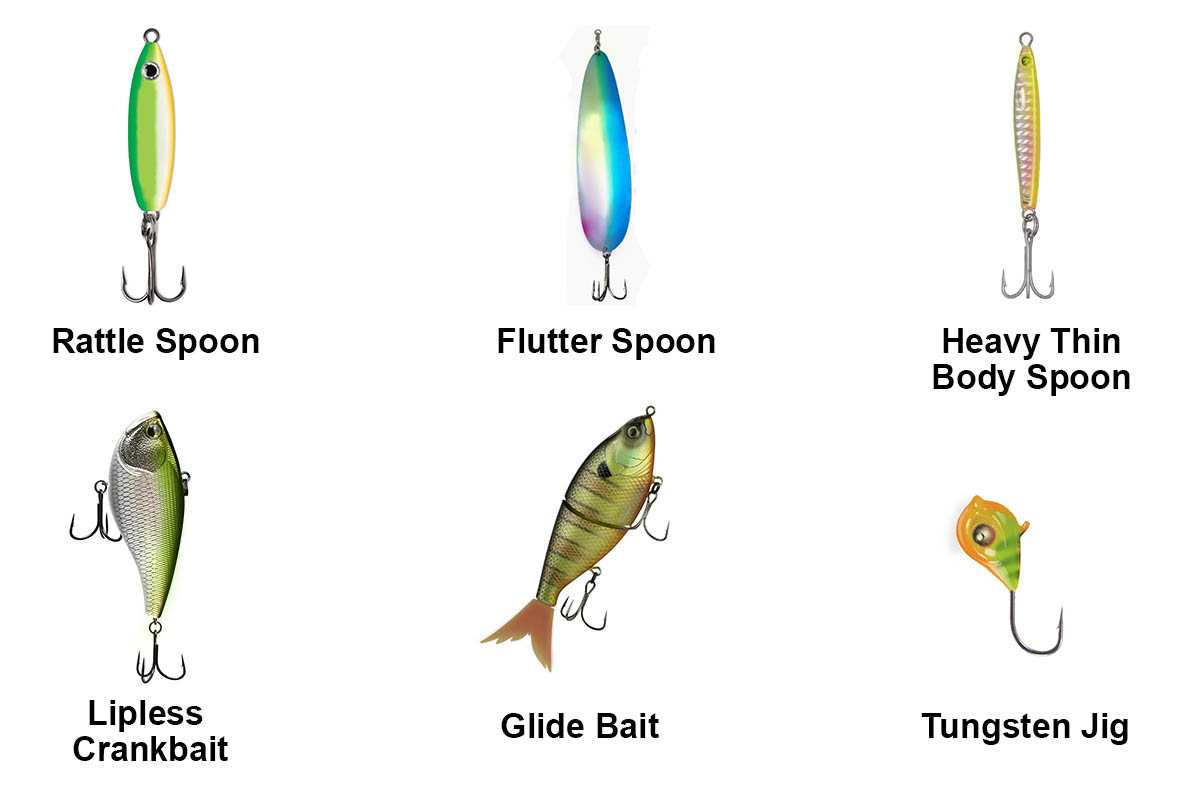
When selecting ice fishing lures, think small. Fished correctly, small lures exhibit a life-like action. This doesn’t mean you shouldn’t fish bigger lures for bigger fish, but when all else fails move down a few sizes. During the winter months fish are going to be sluggisth and they’ll often take a small lure just as readily as they’ll take a large one. Even a pike or walleye won’t pass up a small lure with the right presentation.
Select lures that imitate natural prey for the fish species you’re targeting. The following table provided recommended lures for all the popular fish species you’re likely to encounter while ice fishing.
| Fish Species | Lure Recommendations |
|---|---|
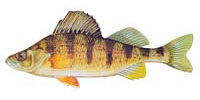 Perch | A small tungsten jig tipped with a wax worm or soft plastic that imitates an insect is an effective setup. Perch will also take small jigging spoons, lipless crankbaits, bladebaits, dropper chains, swimbaits, jigs and soft plastics. To target jumbo shrimp use larger lures. |
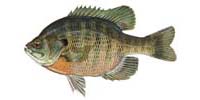 Bluegill | Use lures and presentations that mimic small minnows, insects and larvae. Micro jigs, ice jigs and tear drop jigs in the 1/64 oz to 1/12 oz range between 1/2 to 3/4 inches in length, and micro lipless crankbaits jigged just above the bottom are effective. Tip with a waxie and/or soft plastic. |
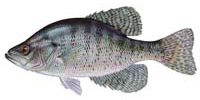 Crappie | Micro and ice jigs coupled with maggots or wax worms. Use small swimming lures that mimic minnows—a favorite for Crappie. Soft plastics, soft plastic baits added to a jig head, blade baits, glide baits and micro crankbaits will get Crappie biting. |
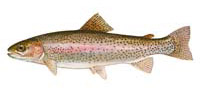 Trout | A small tungsten jig tipped with mealworm or wax worm is unbeatable for targeting trout under the ice. Fly lures that mimic small aquatic insects and nymphs, hair jigs, spoons, bladebaits and hardbaits (rattle traps, lipless crankbaits) are effective. |
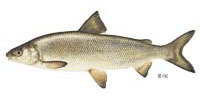 Whitefish | Proven lures for catching whitefish under the ice include jigging raps, hair jigs, weighted flies, soft plastics (paddletail), soft plastics on a jig head, tube jigs, spoons (1/16oz to 1/2oz), bladebaits, and meegs jigs (for bottom fishing). |
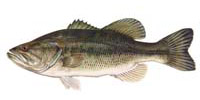 Bass | Largemouth and smallmouth bass will take a variety of small lures during the winters months. A few of the more effective lures include micro jigs (1/12oz to 1/64oz), bucktail jigs, glide baits, jig heads tipped with waxies/mealworms and soft plastics. |
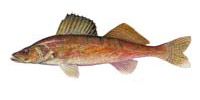 Walleye | Walleye under the ice will take a variety of lures including jigging raps, swimming jigs, horizontal jigs, glide baits, lipless crankbaits; slab, flutter and rattle spoons. |
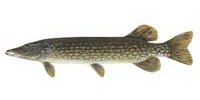 Northern Pike | Pike waiting out the winter under the ice will readily take a number of artificial lures including spoons, glide baits, lipless crankbaits (rattle baits), blade baits and airplane jigs. Pike like lures that are flashy, noisy and exhibit plenty of action. |
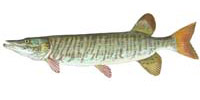 Muskellunge | Muskies will take many of the same lures as pike including spoons, lipless crankbaits, jigs, jigging raps and blade baits. Muskies like lures that provide a lot of action. |
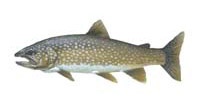 Lake Trout | Probably the best lure for ice fishing lake trout is a white or pearl soft plastic tube that mimics a cisco or minnow. Other baits for fishing lake trout under the ice include swimbaits, bucktail jigs, spoons, and lipless crankbaits. |
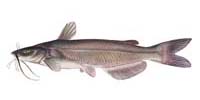 Catfish | Catfish will take a jig head tipped with cut bait presented in a jigging motion near the bottom. Jigging spoons and other ice fishing jigs tipped with cut bait will also catch catfish. The key is to always us a small piece of bait with your lure. |
There are a lot of lures that can be used for ice fishing, but if there are a few universal lures that every serious ice angler should have in their tackle box. These lures will catch everything from yellow perch to giant muskies. They include:
- Rattle spoons
- Flutter spoons
- Heavy thin body spoons
- Lipless crankbaits (large and micro)
- Glide baits
- Tungsten jigs
Rattle spoons are easy to fish, they provide great sound, action, color and they can be fished aggressively or finesse. Flutter spoons are light, flat and when you let your line go loose they flutter to bottom. They’re great for clear water. Heavy thin body spoons have a tight wiggle and fall fast. Great for finesse fishing techniques.
Lipless crankbaits that mimic small preyfish will catch just about everything from panfish to bass to giant muskies. 1/8oz to 1/2oz is the ideal weight for a lipless. For targeting small panfish, I recommend a micro lipless crankbait. The micro crankbait is a bluegill slayer.
You can’t go wrong with a glide bait. They produce a unique gliding action when jigged or ripped. Very effective bait for targeting crappie, pike, walleye, musky and bass under the ice. They come in micro sizes for targeting smaller panfish such as perch and crappie.
Last, but by no means least, are tungsten jigs and soft plastics. Tungsten jigs present live bait or plastics in a super finessy way that creates just the right action to trigger slow lethargic fish to bite. These days you don’t really even need live bait. Attach a finesse plastic to a tungten jig and you’ll be getting bites all day.
A final reminder. For best results, tip your lures with a couple waxies, mealworms or maggots.
Terminal Tackle
Going ice fishing without terminal tackle is like showing up for the Daytona 500 without a pit crew. You need this stuff if you want to have a productive, enjoyable experience ice fishing.
The basic terminal tackle required for ice fishing includes needle-nose pliers, a multi-tool, sinkers (weights), swivels and snaps, a filet knife for cleaning fish, line clippers, scissors, hooks and bobbers. Consider any other tackle required for your fishing method and target species.
Tip Ups
Tip ups allow anglers to fish multiple baited lines under the ice at the same time. A trigger mechanism on the tip up flips up a flag when a fish bites and the bait is taken. You then pull up the fish through the hole in the ice by hand.
There are multiple styles of ice fishing tips ups. Each offers a slightly different design and functionality. The four most popular tip up styles are the Windlass, Pro-Thermal, Hardwood and Wood Stick tip up.
| Tip Up type | Description |
|---|---|
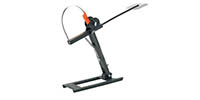 Windlass | A windlass tip up has a small silver paddle that catches the wind and bobs, or 'jigs', the bait up and down in the water column to attract a bite. The windlass tip allows you to adjust spring tension, spool drag and the angle of the unit. It folds up for easy storage and transportation. |
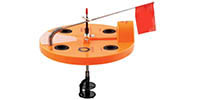 Pro-Thermal | A Pro-thermal tip up is quite the engineering feet. It has a round piece of insulated platistic that fits over the fishing hole and keeps it from freezing. A flag flips when you get a bite and an indicator spins when a fish is on the line. It's ideal for real cold snowy days. |
 Hardwood | Hardwood tip ups are the traditional tip ups. They're made with a heavy piece of wood that acts as a base and keeps the tip up anchored to the ice. They have a large visible flag that flips up when you get a fish on the line. Hardword tip ups typically have a crank handle and spool to reel in the line. |
 Wood Stick | Wood stick tip up is a classic style constructed by attaching two small 15 inch wood beams crossed in an X and laid horizontally over the fishing hole. A vertical beam about 24 inches in length intersect the two crossed beams where they intersect. A spool of line is attached at the bottom of the vertical beam and submerged in water. A flag is attached at the other end of the beam. When a strike occurs, an o-ring mechanism hook to the spool flips the flag up. |
If you’re just getting started, the most important thing is that you buy a quality tip up. A quality tip up will be built on stable base, have an adjustable trigger mechnism, and be constructed of freeze proof components. You also want your tip up to be sturdy enough that it won’t blow over.
I highly recommend making sure your tip up has an adjustable trip bar or tripping mechanism. This will allow you to set the tip up for a light or heavy trip. If you’re targeting small panfish, you’ll set the trip for light bites. If you’re targeting larger fish—such as pike—you’ll set the trip for heavy bites.
Finally, before purchasing a tip up check you’re local fishing regulations. Some states limit the number of lines you can fish under the ice at once.
Ice Shelter
Whether or not an ice fishing shelter is an optional piece of ice fishing gear is really a matter of opinion, but most recreational anglers manage without one. If, however, you’re an avid angler who spends winter weekends hard water fishing, then a quality ice shelter is worth its weight in gold.
A good ice shelter provides protection from harsh winter elements including wind, rain/snow and even the sun. A lot of anglers don’t realize that on sunny winter day the reflection off the ice will get you quicker than the cold. At the end of the day, the biggest benefit of using an ice shelter is that is extends the time you’re able ice fish.
There are various styles of portable ice shelters. The two most popular are Flip-Overs and Hubs (tents).
| Shelter type | Description |
|---|---|
Hud Shelter | Hub ice shelters are light weight, sturdy and provide ample space for groups of 4 or more people. They're ideal for a day on the ice with family and friends. |
Flip-over Shelter | Flip over ice shelters can accomodate 1 to 2 anglers and are designed to be highly portable. They're easy to set up and easy to move around from one fishing hold to the next. |
Neither the hub nor the flip over is necessarily better than the other, they’re just different. Below we’ll explore the advantages and disadvantages of each.
Hub Ice Shelter
Hub shelters, sometimes referred to as pop-up shelters, have a tent like structure supported by poles and durable fabric that is nearly impervious to the elements. The walls of the hub shelter bow out at an angle to provide anglers more room to move about. Although relatively lightweight, a hub shelter takes a while to setup and is really designed to stay in one place. If you plan on fishing in the same spot all day, a hub shelter is a good option.
| Pros | Cons |
|---|---|
|
|
Flip-Over Ice Shelter
Flip-over shelters have a sturdy frame that “flips” up like a convertible top. They’re durable, weather resistant, and best of all quick and easy to set up. Even though they’re heavier than hub shelters, flip-overs are attached to a tub sled and can easily be moved across the ice from one spot to the next by a snowmobile or ATV. Flip-overs are cozy and compact. They typically have space for no more than two anglers, although some models can hold up to four.
| Pros | Cons |
|---|---|
|
|
Ice Shelter Materials
Even if two ice shelters look the same, they may not be the same. When purchasing an ice shelter you want to pay attention to what material it’s made of. Ice shelters can be made from a number of materials, primarily nylon, cotton, polyester and canvas. When evaluating shelter material you want to focus primarily on thickness and thermal technology.
Thicker material is stronger and more durable. It provides protection from the elements and tends to last longer than thinner fabric. The higher the “denier” number (abbreviated “-D”) the thicker the material. A 600-D fabric is going to be three times as thick (and much more durable) than a 200-D fabric. You’re going to pay more for fabric with a higher denier value, but your shelter is going to last longer and provide better protection.
Is the ice shelter using a good thermal fabric? Some don’t. If you’re fishing in cold, windy conditions, you want a shelter that uses a high quality thermal fabric. In the short run, a thermal shelter will cost you more. But you’ll quickly make up the difference in lower heating costs from running a propane heater non-stop to stay warm. It’s no fun ice fishing when you’re freezing your but off. Invest in a shelter that will keep you warm.
Lastly, you want to make sure your shelter is waterproof. Most shelters are advertised as waterproof—and most are waterproof brand new. The question is how long they will remain waterproof. If you purchase a shelter constructed with cheap fabric, its integrity will quickly fade and it’s not going to provide you the protection you want—and thought you paid for.
Portable Heater
If you’re going to be on the ice using a shelter, especially if you’re using a larger hub shelter, a portable heater will make your experience a lot warmer and more enjoyable. This is especially true if temperatures fall below 20 degrees Fahrenheit or you plan on taking kids along. You might be able to handle they cold for a while, but they won’t. Bring along a quality heater, and you can extend the duration of your ice fishing adventure from a few hours to a few days.
There are several types of heaters on the market. Each comes with pros and cons. When evaluating heaters for ice fishing you’ll want to consider the following.
| What to consider | Reason |
|---|---|
| BTUs | How big is your shelter? How warm do you want the inside? 4,000-12,000 BTUs is the range you want to consider. For smaller, insulated shelters you can get away with 3,000-4,000 BTUs. For larger, or uninsulated shelters, you'll want a heater in the 8,000-10,000 BTU range. |
| Run time | Run time will determine how long you're able to fish comfortably. Heater run times vary, but you can expect that a 4,000 BTU propane heater operating off a one-pound propane canister will run about 3-5 hours. Heaters that use larger tanks can run longer |
| Portability | This is a big one in my book. You need to balance power with portability. If you're lugging your own gear around, you want a light-weight heater that will run off a one-pound propane canister. If you're towing a sled with a snow mobile, a larger heater and propane tank is fine. |
| Electric vs Propane | Most anglers prefer using a propane heater over an electric heater. Propane heaters are light, powerful and portable. If safety is your ultimate concern, an electric heater is a good option. They don't use oxygen and they can't cause carbon monoxide poisoning. |
| Reliability | If you're a serious ice angler, you want a serious heater. This starts with reliability. Don't mess around with a cheap heater if you're fishing in sub-zero temperatures. Your heater should start right up—even when it's really cold. |
| Safety | Last, but by no means least, is safety. Carbon monoxide poisoning is a real concern, especially if you're using your heater inside an enclosed shelter. Only use a heater that is rated for indoor use. It should be high quality, have tip over protection and an oxgyen depletion sensor (ODS). I'd also recommend a separate carbon monoxide detector. |
I’ve listed the portable heater as a non-essential ice fishing item, but it’s something I always take with me—even if I don’t end up using it. If the weather is nice on the ice, the heater will remain in the back of my vehicle. But I end up breaking it out more often than not.


